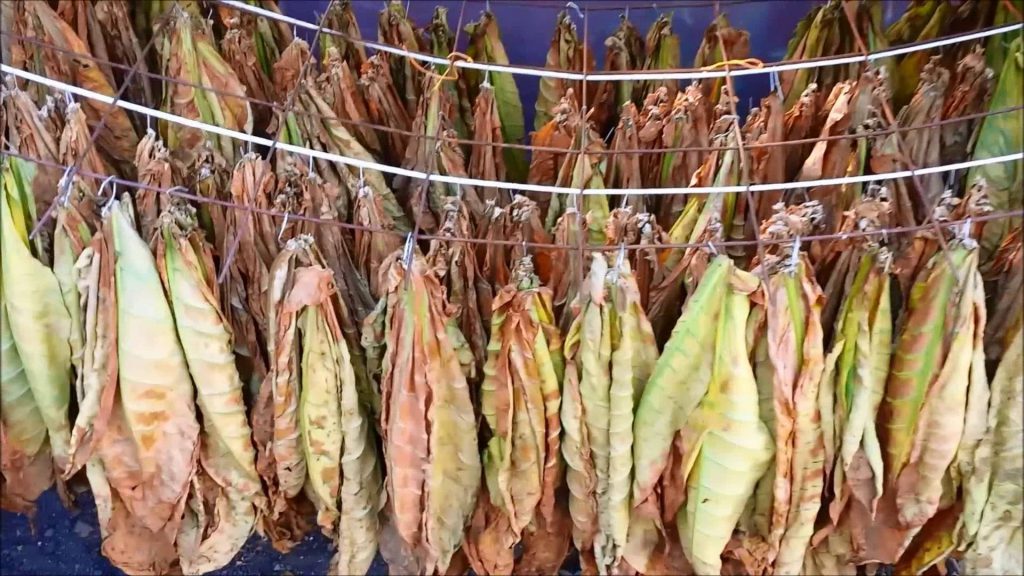 Flue-Cured
Flue-Cured
Flue-cured is also known as “Bright” and “Virginia” by the world trade. It is used almost entirely in cigarette blends. Some of the heavier leaves may be used in mixtures for pipe smoking. Flue-cured leaf is characterized by a high sugar: nitrogen ratio. This ratio is enhanced by the picking of the leaf in an advanced stage of ripeness, and by the unique curing process which allows certain chemical changes to occur in the leaf. Cured leaves vary from lemon to orange to mahogany in color. The leaves are relatively large with the largest at midstalk. A well grown plant will be topped at a height of 39 to 51 inches with 18-22 harvestable leaves. Yields average around 2200 lbs/A with some in excess of 3000 lbs/A. The leaves are harvested as they mature from the ground up. Major flue-cured producers in the world are: China, USA, Brazil, India and Zimbabwe. Flue-cured is grown in six states in the U.S. – Virginia, North Carolina, South Carolina, Georgia and Florida.
Burley
Burley is light air-cured type derived from the White Burley which arose as a mutant on a farm in 1864. Burley is used primarily in cigarette blends. Some of the heavier leaf is used in pipe blends and also for chewing. Cured burley leaf is characterized by low sugar content and a very low sugar to nitrogen ratio. This is enhanced by high N. fertilizer, harvesting at an early stage of senescence, and the air curing process which allows oxidation of any sugars which may have occurred. Burley has a tremendous capacity to absorb flavorings (25% of its own weight vs. 7-8% for flue-cured). Cured leaves vary in color from light tan to reddish and brown. The leaf should be without yellow patches or fringes. The leaves are slightly larger than flue-cured and the plants are generally taller. A typical plant is topped at 20-30 leaves. Average yields are 2500-3000 lbs/A and the plants are stalk cut. The leaves are stripped after curing. The main producers of burley tobacco are the U.S., Italy, Korea, Brazil, and Mexico. In the U.S. production is in Kentucky, Tennessee, Ohio, Virginia, North Carolina, West Virginia and Missouri.
Maryland
Maryland is another light air-cured type. It is used to some extent in American blended cigarettes and to a greater extent in certain Swiss cigarette blends. Maryland tobacco is extremely fluffy, has good burning properties, low nicotine, and neutral aroma. An example of this lightness: a hoghead of redried burley or flue-cured may weigh 800 lbs but the same hoghead will only contain 600 lbs of Maryland. This tobacco is upright and large leaved like burley but is darker green without the creamy midveins. Yields are slightly less than flue-cured. The tobacco is stalk cut and air-cured like burley. The cured leaf is various shades of brown with yellow and green colors being highly undesirable. In the U.S., production is in five Maryland counties around Washington, D. C.
Dark Air-Cured
The dark air-cured term encompasses a number of types used mainly for chewing, snuff, cigar, and pipe blends. Most of the world production is confined to the tropics. In the U.S. dark air-cured tobacco is produced in Kentucky, Tennessee and Virginia: three types are one-sucker, Green River and Virginia sun-cured. These are heavy type leaves, highly fertilized and topped low to around 10-12 leaves. Dark air-cured leaf is high in nicotine and used in chewing and snuff and some pipe mixtures. The plants are stalk cut.
Oriental
Oriental tobacco gives a mild smoke with very characteristic aroma. Resins, waxes and gum exude by glandular hairs (trichomes) furnish the aroma. Nicotine is low averaging around 1.0%. Oriental leaf is characterized by its small size, leaf length is 3-10 inches and is 2-3 times the width. Average plant heights are 3-5 ft. The leaves are hand primed, normally sewn on a string, and are dull yellow to rich brown in color. The leaves are sun-cured. Production is centered in the USSR, Turkey, Bulgaria, Greece, Yugoslavia, Romania and Italy.
Perique
Produced in St. James Parrish in South Louisiana. Curing consists of a period of moisture loss in the open, followed by successive periods of high pressure treatment in barrels. The final product is very black with a characteristic odor almost like perfume. It is used in a few specialized pipe mixtures.
Tobacco Growers Info Panel
Independent Leaf Tobacco is pleased to introduce you to the
Tobacco Growers Information Portal–where you will find
extensive resources on tobacco production and marketing.
The College of Agricultural and Life Sciences at North
Carolina State University provides extensive educational and
research resources to the tobacco farm sector encompassing
agronomics, plant pathology, entomology, agricultural
engineering, and agricultural economics.
Independent Leaf Tobacco hopes that the Tobacco Growers
Information Portal increases the usefulness of our
resources, in turn improving the lives and businesses of
North Carolina farm families.
